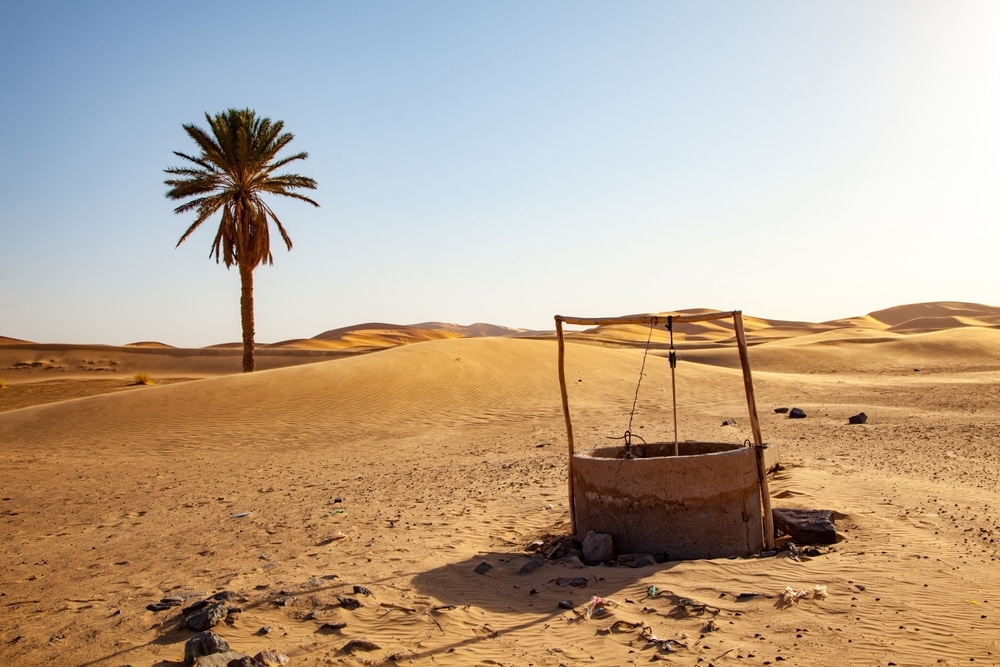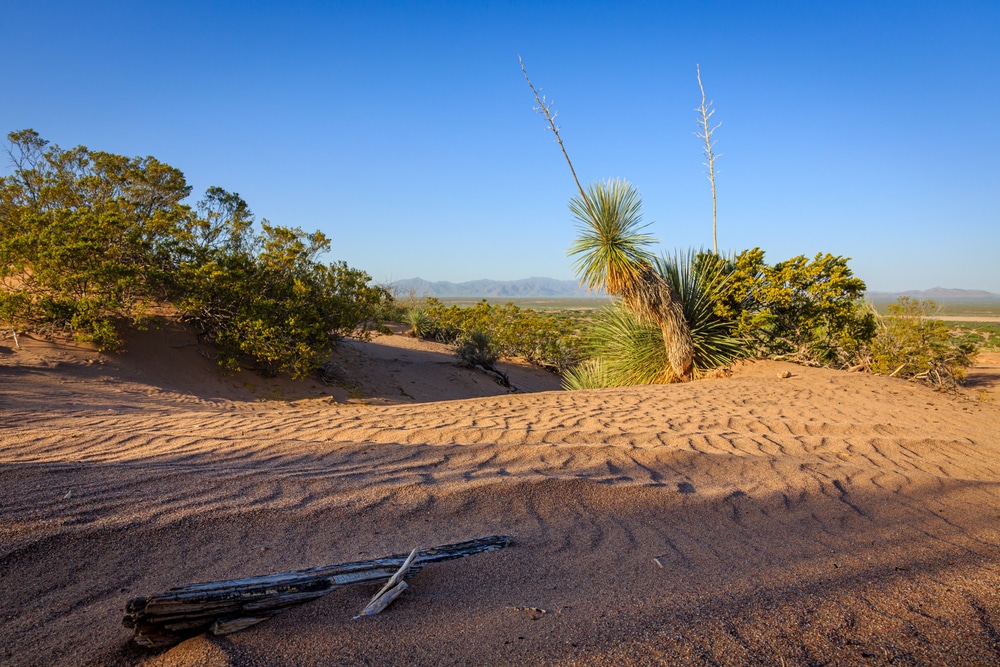Nestled in the high desert of southeastern Arizona lies Hot Well Dunes Recreation Area, a fascinating blend of natural beauty and geothermal wonder managed by the Bureau of Land Management (BLM). This 2,000-acre recreation area offers visitors an unexpected desert experience where shifting sand dunes meet bubbling hot springs, creating a unique destination for outdoor enthusiasts, off-highway vehicle (OHV) riders, and those seeking relaxation in natural thermal waters.
Located approximately 32 miles southeast of Safford in Graham County, Hot Well Dunes stands as a testament to Arizona’s diverse landscapes and geological marvels. The recreation area derives its name from two artesian thermal wells that were originally drilled in the 1920s for irrigation purposes by local farmers. When the wells failed to produce sufficient water for agriculture, they were abandoned, inadvertently creating what would eventually become a recreational resource cherished by locals and visitors alike.

The star attraction of Hot Well Dunes is its natural hot springs, which are fed by geothermal water from a well drilled in the 1920s. Two soaking tubs are available for visitors, offering a relaxing experience in warm, mineral-rich water. The tubs are open year-round and provide a peaceful way to unwind after a day of exploring the dunes. Visitors should note that the use of the tubs is first-come, first-served, and temperatures may vary slightly depending on the season.
The recreation area is a popular destination for OHV enthusiasts, with over 2,000 acres of open sand dunes to explore. Riders can enjoy the thrill of driving across the rolling dunes, which offer challenges for all skill levels. Whether you’re riding dirt bikes, ATVs, or dune buggies, this area provides an exciting playground for off-road adventures. Riders must have valid permits and adhere to all safety regulations, including helmet requirements.

Beyond the dunes, the surrounding desert landscape offers opportunities for hiking and exploring. Visitors can wander through the Chihuahuan Desert, observing the unique flora and fauna of the area. The landscape is dotted with creosote bushes, mesquite trees, and cacti, and you may encounter wildlife such as jackrabbits, lizards, and desert birds.

Camping at Hot Well Dunes is a great way to fully immerse yourself in the desert experience. The area offers primitive campsites with fire rings and picnic tables. While there are no hookups or modern facilities, the quiet desert setting is perfect for stargazing and enjoying the natural beauty of the dunes. Camping is on a first-come, first-served basis, and visitors should pack out all trash and follow Leave No Trace principles.

The unique combination of sand dunes, desert plants, and the tranquil hot springs makes Hot Well Dunes a great destination for photography. Capture:

The Hot Well Dunes area is home to various desert species, making it a great spot for wildlife watching. Early mornings and evenings are the best times to spot animals like:
With its remote location far from city lights, Hot Well Dunes Recreation Area is an excellent spot for stargazing. On clear nights, visitors can enjoy incredible views of the Milky Way, constellations, and meteor showers. Bring a telescope or simply lay back and enjoy the quiet beauty of the night sky.


| Category | Details |
|---|---|
| Location | Southeastern Arizona, near Safford in Graham County |
| Managed By | U.S. Bureau of Land Management (BLM) |
| Size | Approximately 2,000 acres (809 hectares) |
| Main Attractions | Natural hot springs, sand dunes, and scenic desert landscapes |
| Ecosystem | Sonoran Desert ecosystem with sand dunes, desert shrubs, and riparian areas |
| Wildlife | Includes desert species such as jackrabbits, lizards, snakes, and various birds |
| Recreation Activities | ATV and off-road vehicle riding, camping, soaking in hot springs, wildlife viewing, and photography |
| Hot Springs | Two concrete pools fed by natural hot springs with water temperatures averaging 106°F |
| Popular Features | Sand dunes ideal for off-highway vehicles (OHVs) and recreational vehicles |
| Nearby Landmarks | Mount Graham, Gila Box Riparian National Conservation Area, and Safford |
| Climate | Hot summers and mild winters, with occasional rainfall during monsoon season |
| Camping | Dispersed camping is allowed; primitive campsites with picnic tables and fire rings are available. There is no potable water. |
| Accessibility | Access roads are unpaved and may require high-clearance vehicles |
| Entrance Fee | $3 per vehicle per day, or $30 for an annual pass (fees subject to change) |
| Fun Fact | The hot springs were originally created in the 1920s from a failed oil-drilling attempt! |
The landscape of Hot Well Dunes is characterized by its rolling sand dunes, which rise up to 250 feet above the surrounding desert floor. These dunes, composed of fine quartz sand, are remnants of an ancient lakebed that existed thousands of years ago. When the prehistoric lake dried up, prevailing southwestern winds gradually shaped the exposed sand into the undulating dune formations visible today. This isolated dune system, surrounded by classic Chihuahuan Desert vegetation, creates a striking visual contrast against the backdrop of distant mountain ranges.
What truly sets Hot Well Dunes apart from other desert recreation areas is the presence of two concrete hot tubs fed by geothermal springs. These natural hot springs maintain a constant temperature of approximately 106°F (41°C) year-round, offering a therapeutic soaking experience in the midst of an arid landscape. The mineral-rich waters, containing calcium, magnesium, and other elements, attract visitors seeking both recreation and the purported health benefits of natural thermal springs.
Hot Well Dunes Recreation Area represents an important piece of Arizona’s public lands mosaic, providing diverse recreational opportunities while preserving a unique desert ecosystem. Whether visitors come for the thrill of OHV riding across the dunes, the relaxation of soaking in natural hot springs, or simply to experience the tranquility of this desert setting, Hot Well Dunes offers a distinctive outdoor experience that highlights the unexpected treasures found within Arizona’s public lands.
Hot Well Dunes Recreation Area is situated in the southeastern portion of Arizona, approximately 32 miles southeast of Safford and about 65 miles northeast of Tucson. The recreation area lies within Graham County at an elevation of approximately 3,500 feet above sea level. This relatively isolated location contributes to its unspoiled character while remaining accessible to visitors.
Access to Hot Well Dunes is via a well-maintained gravel road that can accommodate standard passenger vehicles under dry conditions:
While the access road is generally navigable by passenger cars in dry conditions, visitors should check weather forecasts before traveling, as the road can become impassable when wet. During summer monsoon season (July-September), afternoon thunderstorms can temporarily flood low water crossings. Four-wheel drive or high-clearance vehicles are recommended during wet weather periods.
The defining geological feature of Hot Well Dunes is its impressive sand dune system, which covers approximately 2,000 acres. These dunes represent a geological anomaly in the region, as they are isolated from other major dune systems. Scientific studies suggest that the sand originated from an ancient lakebed that existed in the Safford Basin during the Pleistocene epoch, between 2.5 million and 11,700 years ago.
The dunes are primarily composed of fine-grained quartz sand that appears light tan to golden in color. Individual dunes reach heights of up to 250 feet above the surrounding desert plain and exhibit various dune formations, including crescent-shaped barchan dunes, linear dunes, and complex star dunes. Wind patterns continually reshape these formations, making the landscape subtly different with each visit.
Beyond the dunes themselves, the landscape features several interesting geological characteristics:
Basin and Range Topography: Hot Well Dunes lies within the Basin and Range Province, characterized by north-south trending mountain ranges separated by flat valleys or basins. The recreation area is situated within one such basin, with the Pinaleño Mountains visible to the southwest and the Gila Mountains to the north.
Geothermal Activity: The thermal wells that give the area its name are evidence of significant geothermal activity beneath the surface. Groundwater percolates deep into the earth’s crust, where it is heated by geothermal energy before rising back to the surface through the drilled wells.
Desert Pavement: In areas surrounding the dunes, visitors may notice desert pavement—a natural arrangement of rocks and pebbles that form a mosaic-like surface protecting the underlying soil from erosion.
The juxtaposition of these geological elements creates a visually stunning landscape that offers insights into the region’s complex geological history.
Hot Well Dunes experiences a high desert climate characterized by four distinct seasons, substantial temperature variations between day and night, and limited precipitation. This climate pattern significantly influences visitor experiences throughout the year:
Summer (June-September): Daytime temperatures frequently exceed 100°F (38°C), with occasional peaks reaching 110°F (43°C). The summer monsoon season brings scattered afternoon thunderstorms, which can produce spectacular lightning displays, flash flooding, and temporary respites from the heat. Humidity levels increase slightly during this period.
Fall (October-November): Considered one of the most pleasant seasons at Hot Well Dunes, fall brings moderate daytime temperatures ranging from 65-85°F (18-29°C) and cool evenings. Precipitation levels decrease, and skies are typically clear with excellent visibility.
Winter (December-February): Daytime temperatures range from 50-65°F (10-18°C), while nighttime temperatures can drop below freezing, occasionally reaching the low 20s°F (-7°C). Snow is rare but possible during cold fronts. Winter presents clear, crisp conditions ideal for daytime recreation and nighttime stargazing.
Spring (March-May): Another favorable season for visitation, spring features gradually warming temperatures ranging from 70-90°F (21-32°C). Spring tends to be the windiest season, which can enhance sand dune formation but may create challenging conditions for some activities. Precipitation remains minimal, though occasional spring storms can occur.
Annual precipitation averages approximately 10 inches (25 cm), with the bulk occurring during the summer monsoon season and winter months. The combination of limited rainfall, high evaporation rates, and permeable sandy soil results in minimal surface water apart from the developed hot springs.
Hot Well Dunes Recreation Area represents a fascinating ecological transition zone where elements of both the Sonoran and Chihuahuan Deserts intermingle, creating a diverse desert ecosystem. The area showcases how plants and animals have adapted to survive in an environment characterized by limited water, temperature extremes, and shifting substrates.
The dune system itself creates numerous microhabitats based on exposure, elevation, and sand stability. Active dunes with shifting sands support minimal vegetation, while more stable interdune areas allow plant communities to establish. This habitat heterogeneity contributes to the area’s surprising biological diversity.
Plant life at Hot Well Dunes demonstrates remarkable adaptations to desert conditions. The vegetation varies considerably between the active dune areas and the surrounding desert flats:
Dune Vegetation: On the dunes themselves, plant coverage is sparse due to the challenging growing conditions of shifting sand. Species that have adapted to this environment include:
Surrounding Desert Vegetation: The more stable areas surrounding the dunes support a greater diversity of plant species, including:
Seasonal wildflowers create spectacular displays following periods of adequate rainfall, particularly in spring. Desert marigold, globemallow, desert lupine, and numerous other species transform the landscape with brief but vibrant blooms.
The geothermal springs have created small wetland microhabitats surrounding the developed hot tubs, where moisture-loving plants thrive in stark contrast to the surrounding arid environment.
The diverse habitats within Hot Well Dunes support a surprising variety of animal species, many of which have evolved specialized adaptations for desert survival. Visitors may encounter:
Mammals: The recreation area hosts a variety of desert-adapted mammals including:
Reptiles: Well-adapted to desert conditions, reptiles are abundant during warmer months:
Birds: The recreation area attracts a variety of avian species:
Invertebrates: A critical but often overlooked component of the ecosystem includes:
Many desert animals are crepuscular (active at dawn and dusk) or nocturnal to avoid daytime heat, making early morning and evening the best times for wildlife observation.
Hot Well Dunes Recreation Area offers a diverse range of recreational activities that appeal to various interests, making it a multifaceted destination for outdoor enthusiasts.
One of the primary attractions of Hot Well Dunes is the opportunity for off-highway vehicle riding across its extensive dune system. The recreation area is one of only two designated OHV areas managed by the BLM in southeastern Arizona, making it a popular destination for enthusiasts:
The BLM has established specific regulations to ensure safety and resource protection:
Riders are encouraged to practice responsible OHV principles, including staying on designated dunes, respecting closed areas, and yielding to non-motorized users.
The thermal wells that give the area its name provide a unique recreational opportunity in this desert setting. Two concrete hot tubs capture the flowing artesian well water, which maintains a consistent temperature of approximately 106°F (41°C):
The hot springs create a particularly magical experience during cooler seasons when the contrast between the desert air and warm water is most pronounced. Many visitors plan their activities to enjoy the hot tubs during early morning or evening hours, when temperatures are most comfortable and the setting is enhanced by dramatic lighting.
Hot Well Dunes offers primitive camping throughout the recreation area, providing visitors the opportunity to experience the desert’s tranquility and spectacular night skies:
Camping facilities and considerations include:
Campers must pack in all necessary supplies, including drinking water, and pack out all trash. Campfires are permitted when fire danger is low, but visitors must bring their own firewood, as collection of vegetation is prohibited.
While not officially designated, informal hiking opportunities exist throughout Hot Well Dunes:
Hikers should be aware that much of the recreation area is also open to OHV use, requiring awareness and caution where these uses overlap.
Hot Well Dunes offers exceptional opportunities for both photography and stargazing:
Photography highlights include:
Stargazing conditions are optimal due to:
Amateur astronomers often bring telescopes to take advantage of these excellent conditions, while casual observers can enjoy spectacular naked-eye astronomy.
Hot Well Dunes Recreation Area experiences significant seasonal variations that affect visitor experiences throughout the year. Understanding these patterns helps visitors plan trips that maximize enjoyment while ensuring comfort and safety.
Fall represents one of the most favorable seasons for visiting Hot Well Dunes:
Fall visitors should pack layers to accommodate temperature variations between day and night and can generally expect excellent conditions for all recreation activities.
Winter brings mild days and cold nights to Hot Well Dunes:
Winter visitors should prepare for cold nights with appropriate sleeping gear if camping, and morning activities may require warm clothing until temperatures rise. The contrast between cool air and warm hot springs creates a particularly enjoyable soaking experience.
Spring offers another prime visitation period:
Spring visitors should secure campsites early on weekends and holidays, bring windbreaks for camping comfort, and prepare for occasional windy conditions. Windier days can impact OHV riding visibility and comfort, though many enthusiasts enjoy the enhanced dune-building conditions.
Summer presents the most challenging conditions at Hot Well Dunes:
Summer visitors must take serious heat precautions, including carrying abundant water, planning activities for early morning or evening hours, ensuring vehicles are well-maintained to prevent breakdowns in extreme heat, and being prepared for sudden thunderstorms that can cause flash flooding on access roads.
Based on these seasonal patterns, the most favorable times to visit Hot Well Dunes Recreation Area are:
These periods offer the best combination of comfortable temperatures, stable weather conditions, and moderate visitation levels. Weekend visitors during these optimal times should arrive early to secure preferred camping locations, especially if planning to stay near the hot springs.
Hot Well Dunes Recreation Area is accessible via a maintained gravel road that is generally passable by passenger vehicles in dry conditions:
From Tucson:
From Phoenix:
GPS Coordinates for the recreation area entrance: 32°54’33″N, 109°51’56″W
Important access considerations:
Hot Well Dunes offers basic facilities consistent with its designation as a primitive recreation area:
Developed Facilities:
Camping Considerations:
Services:
The primitive nature of facilities requires visitors to be self-sufficient and well-prepared for their stay. Most regular visitors appreciate this undeveloped character as part of the area’s appeal.
Visitors to Hot Well Dunes must adhere to BLM regulations designed to protect the resource and ensure visitor safety:
OHV Regulations:
Camping Regulations:
Hot Springs Etiquette:
General Regulations:
These regulations are enforced through periodic patrols by BLM rangers. Violations may result in citations and fines.
The remote location and desert environment of Hot Well Dunes present several safety considerations visitors should prepare for:
Water and Hydration:
Weather Hazards:
OHV Safety:
Hot Springs Safety:
Isolation Considerations:
Wildlife Awareness:
Being prepared for these potential hazards ensures a safer and more enjoyable experience at Hot Well Dunes. Self-sufficiency and conservative decision-making are essential given the area’s remoteness.
The lands encompassing and surrounding Hot Well Dunes have a rich cultural history dating back thousands of years. Archaeological evidence indicates that indigenous peoples, particularly ancestors of the modern Puebloan and Apache groups, utilized this region for seasonal hunting and gathering activities.
While major settlements were typically located closer to reliable water sources along the Gila River to the north, the dune area likely served as a travel corridor and seasonal resource zone. Evidence of this historical use includes:
The San Carlos Apache Tribe and the Tohono O’odham Nation maintain cultural connections to the broader region, with traditional knowledge of plant resources, water sources, and seasonal use patterns. Several plants found in the area, including mesquite, yucca, and various cacti, have traditional uses for food, medicine, and crafts.
Visitors who encounter archaeological artifacts should observe them respectfully without disturbance, as they are protected by federal law. Collection of artifacts is strictly prohibited, and discoveries should be reported to BLM staff to ensure proper documentation and preservation.
The broader region surrounding Hot Well Dunes has a significant mining history that influenced settlement patterns and development. While major mining activities were concentrated in the nearby Safford Mining District and Gila Mountains, smaller prospecting operations occasionally extended into areas surrounding the dunes.
The most direct historical influence on the recreation area came in the 1920s, when local farmers drilled several artesian wells in the area hoping to develop irrigation water for agriculture. These drilling operations unexpectedly tapped into geothermal waters, creating the hot springs that now define the recreation area. When the wells proved insufficient for large-scale irrigation, they were eventually abandoned.
During the mid-20th century, the land was primarily used for cattle grazing, with ranching operations utilizing the surrounding grasslands and scrubland. Evidence of this ranching history can still be seen in some of the fence lines and water developments in adjacent areas.
Hot Well Dunes Recreation Area’s modern management history began when the Bureau of Land Management recognized its recreational potential and began developing minimal facilities to protect the resource while accommodating visitors. Key developments in the area’s management history include:
The BLM continues to manage Hot Well Dunes with a multiple-use philosophy, balancing recreational access with conservation of natural and cultural resources.
Managing Hot Well Dunes presents several environmental challenges that require ongoing attention from both the BLM and visitors:
OHV Impact Management: Balancing recreational OHV use with resource protection represents the most significant management challenge. The BLM addresses this through:
Vegetation Protection: While the active dunes naturally have minimal vegetation, the surrounding desert ecosystem requires protection from unnecessary disturbance. Management approaches include:
Water Resource Protection: The geothermal waters represent a unique resource requiring specific protection measures:
Waste Management: With no trash collection on-site, proper waste management depends largely on visitor cooperation:
Visitors play a crucial role in preserving Hot Well Dunes for future generations. Responsible recreation practices that minimize impacts include:
By practicing responsible recreation and stewardship, visitors help ensure that Hot Well Dunes remains a unique desert oasis for future generations to discover and enjoy.
We use cookies to improve your experience on our site. By using our site, you consent to cookies.
Manage your cookie preferences below:
Essential cookies enable basic functions and are necessary for the proper function of the website.
Statistics cookies collect information anonymously. This information helps us understand how visitors use our website.
Marketing cookies are used to follow visitors to websites. The intention is to show ads that are relevant and engaging to the individual user.